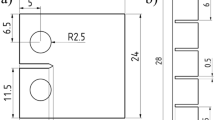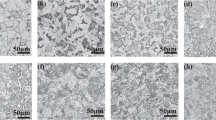Abstract
THE conventional method of determining hydrogen in steel is vacuum extraction at 600°–700° C. Small specimens are heated, and the gases evolved are pumped off and collected in a suitable measuring system. It is generally accepted that the bulk of the hydrogen present in the steel is evolved under these conditions and that hydrogen is the principal component of the gases. Initially, separation of hydrogen from other gases was considered unnecessary1, but it has become common practice to pass the hydrogen through a palladium tube or to oxidize it with cupric oxide. The composition of the other gases, which may constitute 10–40 per cent of the total, is unknown, and there are considerable variations in analytical practice with regard to the elimination of moisture by freezing or reduction over ferro-manganese.
This is a preview of subscription content, access via your institution
Access options
Subscribe to this journal
Receive 51 print issues and online access
$199.00 per year
only $3.90 per issue
Buy this article
- Purchase on Springer Link
- Instant access to full article PDF
Prices may be subject to local taxes which are calculated during checkout
Similar content being viewed by others
References
Newell, N. C., J. Iron and Steel Inst., 141, 243 P (1940); 148, 278 P, 287 P (1943).
Andrew, J. H., Lee, J., Lloyd, H. K., and Stephenson, N., J. Iron and Steel Inst., 156, 208 (1947). Podgurski, H. H., Trans. Met. Soc., Amer. Inst. Mech. Eng., 221, 389 (1961). Sklyuyev, P. V., Kvater, L. I., and Shapiro, V. E., Stal., 10, 909 (1956).
Sachs, K., in The Determination of Gases in Metals, J. Iron and Steel Inst. Spec. Rep. No. 68, 243 (1960).
Körber, F., and Ploum, H., Mitt. Kaiser Wilhelm-Inst. Eisenforschung., 14, No. 16 229 (1932). Naumann, F. K., Stahl u. Eisen, 57, 889 (1937).
Calmettes, J., Dubois, C., and Bastien, P., Mem. Sci. Rev. Met., 56, No. 7 641 (1959). Keel, C. G., Schweiz. Arch. angew. Wiss. Tech., 19, Nos. 4 and 5, 113, 153 (1953). Tyou, R., and Hans, A., Rev. de Met., 58, No. 2, 187 (1961).
Bach, B. B., Dawson, J. V., and Smith, W. W. L., J. Iron and Steel Inst., 176, 257 (1954).
Author information
Authors and Affiliations
Rights and permissions
About this article
Cite this article
SACHS, K., ODGERS, M. Hydrocarbons in the Gases evolved from Steel in Vacuum Extraction at 600° C.. Nature 197, 373–374 (1963). https://doi.org/10.1038/197373a0
Issue Date:
DOI: https://doi.org/10.1038/197373a0
Comments
By submitting a comment you agree to abide by our Terms and Community Guidelines. If you find something abusive or that does not comply with our terms or guidelines please flag it as inappropriate.



